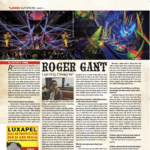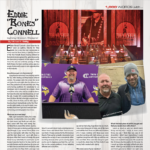
Ethan Weber is a lighting designer and lighting director, perhaps best known for his longtime work with the Rolling Stones, having started with the band as lighting crew chief in 1994 for the Voodoo Lounge tour. Weber played in a band in college as well as worked as a stagehand and production manager on tours that came through his college in Rhode Island. After school, he came to New York City where he got work at See Factor Industries as an electrician and crew chief as well as designing tours and acts. Weber went freelance after a decade at See Factor and today has an extensive resume of lighting design and direction work with artists and bands including Lou Reed, Van Morrison, Joe Cocker, P!nk, My Chemical Romance, Angels & Airwaves, U2, Green Day and The Rolling Stones among others.
PLSN: How did you end up in this industry?
Ethan Weber: Growing up, I always enjoyed music and going to concerts. I went to a college in Rhode Island that turned out to have a pretty good concert committee — U2 in their early days, James Brown, Eurythmics. I spent a few years working as a hand and, eventually, became production manager. Through my work there, I met Abbey Rosen Holmes, booking agents at Metropolitan Concerts and Bob Morrissey at (then) Polico Lighting, but never considered that it could be a career.
After graduating, I moved down to New York with the little punk rock band I was playing in. I needed a job and interviewed to become a manager trainee at Store 24 [a convenience store chain]. I was a couple days from starting when a friend suggested I call Abbey at See Factor Lighting. She was, luckily, off tour when I called and, a few hours later, I was in the shop pulling cable and learning the difference between narrow and medium bulbs. Kind of typical — I think back then most of us fell into this business.
Were there particular jobs that set you on the course of your career, or were milestones?
Through See Factor, one of the bigger production companies in the ‘70s and ‘80s, I met some people that became pivotal to my career. Bob See, who had been Bowie and Rod Stewart’s designer, offered me up to Jonathan Smeeton to run a Lou Reed tour in 1986. Bob and I designed Lou’s next tour together and I spent the next eight or so years as Lou Reed and The Velvet Undergrounds’ designer.
Bob and Michael Ahern [production manager] were good friends, so I did a fair amount of shows with Michael. I called him when I heard he was putting together a Keith Richards’ solo tour — he had already hired an LD, but offered me the crew chief position, which I took. After the European leg, they fired the LD and Michael asked if I’d re-design it and take it over. That and knowing Patrick Woodroffe from several See Factor tours led to my now 26 years with the Stones. Through my time with them, I’ve met and worked with many great people who’ve had much influence on my career — Patrick, Jake Berry, Opie Skjerseth, Mark Fisher, Willie Williams. Working for Willie as director on the U2 360˚ tour would be another major milestone that I look back on with great fondness.
What do you think is an essential element needed in the designer/lighting director relationship?
As a designer — trust, I think, is the biggest thing. That, and finding somebody who has a similar eye or who can adapt their style to fit yours. I need to trust that my director will spend the time and energy to make the show as good as it can be every day. I want the person who’s taking over my shows to have some autonomy and ownership of it but prefer that there’s some continuity between what I’ve left them and whatever they’ve had to add as a tour goes on. Similarly, when I’m directing for another designer — I like to have some creative input, but always try to fit whatever I do into their vision. Important as a director to be a bit of a chameleon.
Who have some of your mentors been?
There are a lot. Bob See was the first one. He took me under his wing and taught me the basics. Whatever my ‘style’ has developed into over the years has been aided by talks with/working for/seeing shows by — Patrick Woodroffe, Willie Williams, Mark Fisher, Dave Hill, Chip Monck, Steve Cohen, Roy Bennett, Abbey Rosen Holmes, Marc Brickman, Bob Barnhart, Howard Ungerleider.
Is there a piece of advice that has stayed with you?
A few things — after complaining about a summer job at a printing company my mother told me not to “wish your life away” counting the days until the summer was over. I hear too many people wishing for the end of a tour. We all have bad days, but I generally enjoy whatever work I’m doing and try to make the most of it. My father’s Germanic work ethic set a good example. And a few others — Patrick, “If you want to make a stage red, do it with 20 lights, not 8.” Willie, “Less is more.” Marc Brickman, “Be nice to everyone on your riser; you never know who they are.”
What advice would you give?
Work hard and get along with people. Treat everyone with respect — touring and locals. Be humble and leave yourself open/receptive to other ideas/viewpoints. Don’t half-ass anything.
What has surprised you most about your career?
Probably the whole thing. Fell into it after college, thought I’d give it a couple years — 35 years later I’ve run lights in front of over a million people on the beach in Rio, spent three years touring the world with a huge rocket ship, lit the Rolling Stones in Cuba, Russia, India, China. Love it all and take none of it for granted.


